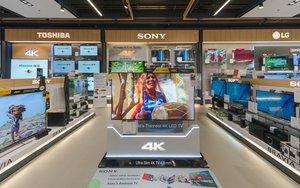Commentary
Internet-Connected TV Penetration Reaches 74%
- by Chuck Martin , Staff Writer, February 7, 2017
 The television is becoming part of the Internet of Things in a big way.
The television is becoming part of the Internet of Things in a big way.
The smartphone already evolved into the hub or central control point for most smart objects. These range from turning lights on and off to remotely monitoring front door or inside-the-home activity.
In addition to the phone, and all the new Internet-connected home gadgetry, such as small appliances or remote switches, there remains one massively connected object in most homes, and that’s the television.
Consumers long ago either figured out (or had an installer figure out for them) how to get an in-home network up and running. That created the base for things to connect to, nicely ushering in the ability to add more TVs to the network.
The penetration of Internet-connected TVs among U.S. broadband households has increased about 50% since 2013, based on a new study.
Almost three-fourths (74%) of households now have an Internet-connected TV, according to the survey of 2,000 U.S. adult broadband users, conducted by The Diffusion Group.
Connected TV penetration grew 22% between 2013 and 2014 and another 15% between 2014 and the next year. Growth has somewhat slowed as the market nears saturation. Here is the pattern of connected TVs households over the years:
- 2013 – 50%
- 2014 – 61%
- 2015 – 70%
- 2016 – 74%
Television manufacturers saw this coming, and as a result, smart TVs dominate at retail. Any consumer looking to purchase a new TV is likely to get one that is Internet connectable, whether requested or not.
The TV and smartphone are sort of in the same boat for IoT in the home. Both already were widely adopted and used, so the leap for the TV and smartphone to join the IoT revolution was hardly a big one.
This column was previously published in Connected Thinking on January 29, 2017.



